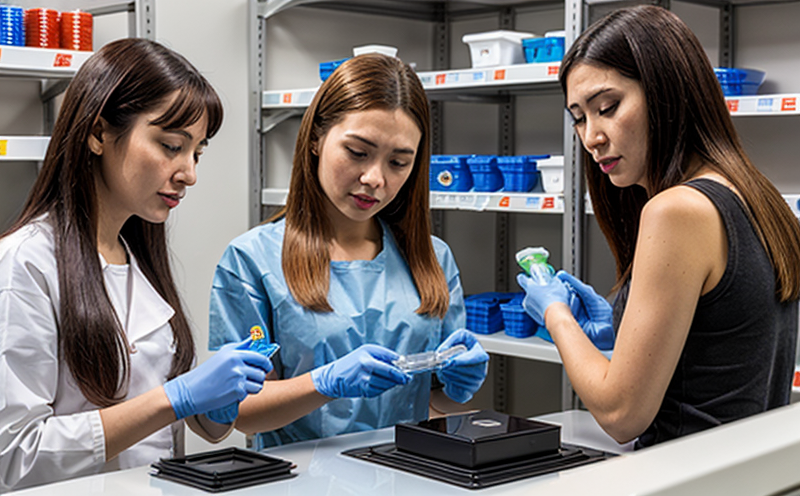UL 181 Resistance Testing of Plastic Duct Consumer Products
The UL 181 standard is a cornerstone in assessing the resistance of plastic duct products to flame and heat. This service ensures that consumer products made from plastics meet stringent safety requirements, safeguarding users against potential fire hazards. The test evaluates how well plastic materials withstand exposure to flames or high temperatures without igniting readily or spreading fire. It’s particularly critical for residential and commercial applications where ventilation systems are key components.
UL 181 resistance testing is essential in the design and manufacturing stages of consumer products, especially those involved with air handling and distribution. By ensuring compliance with this standard, manufacturers can enhance product safety without compromising functionality or aesthetics. This service addresses a vital aspect of product development—safety assurance that aligns with international standards.
The UL 181 test is designed to simulate the conditions under which plastic duct products might be exposed to fire hazards in real-world scenarios. It involves subjecting specimens to controlled flame and heat exposure, measuring their resistance levels, and assessing any damage or deformation. This process provides critical data for manufacturers to refine product designs and materials.
For quality managers and compliance officers, understanding the nuances of UL 181 testing is crucial. The test not only ensures that products meet regulatory requirements but also contributes to brand reputation by demonstrating a commitment to safety. R&D engineers can leverage this service to innovate safer, more durable materials for duct applications.
From a broader perspective, UL 181 resistance testing plays a pivotal role in enhancing public health and safety. By preventing fires caused by poorly designed or manufactured plastic ducts, this service contributes significantly to reducing the incidence of fire-related accidents. This is particularly relevant for residential settings where ventilation systems are integral to maintaining indoor air quality.
The UL 181 standard also supports sustainability efforts. By promoting safer and more reliable product designs, it indirectly encourages responsible manufacturing practices that minimize waste and promote longer-lasting products. The testing process itself can be optimized to use less energy and produce fewer emissions, further contributing to environmental responsibility.
Manufacturers who opt for UL 181 resistance testing gain a competitive edge by ensuring their products meet or exceed safety standards. This service is indispensable for companies looking to comply with international regulations while enhancing product performance and reliability. By investing in this testing, manufacturers can build trust with consumers and regulatory bodies alike.
Scope and Methodology
| Aspect | Description |
|---|---|
| Test Specimens | The test specimens are typically 150 mm long, with a cross-sectional area of at least 300 square millimeters. The specimens must be representative of the product's design and materials. |
| Temperature Exposure | Specimens are exposed to a temperature of 950°C ±25°C for no less than 180 seconds. This duration is chosen to simulate real-world scenarios where plastic ducts might be exposed to intense heat. |
| Flame Application | A propane flame is applied at one end of the specimen, with a nominal flame length of 32 mm. The flame is held for no less than 15 seconds before being extinguished. |
| Data Collection and Reporting | Data includes the time it takes for the specimen to ignite, burn, and extinguish after exposure, as well as any signs of deformation or melting. Reports are generated based on these observations. |
The UL 181 resistance test is designed to evaluate plastic duct products' ability to withstand flame and heat exposure. The scope encompasses a wide range of materials commonly used in consumer products, including polyvinyl chloride (PVC), polyethylene (PE), and acrylonitrile butadiene styrene (ABS). This service ensures that the tested products meet or exceed the stringent safety requirements set by UL 181.
The methodology involves subjecting specimens to controlled conditions of temperature and flame exposure. The test is conducted in a specialized laboratory environment, ensuring consistent and reliable results. Compliance officers and quality managers can rely on this testing to ensure that their products are safe for consumer use.
Benefits
The UL 181 resistance test offers numerous benefits to manufacturers of plastic duct consumer products. Primarily, it ensures compliance with international safety standards, which is crucial for market access and customer trust. By meeting these standards, manufacturers can avoid costly recalls and legal disputes.
Furthermore, this service enhances product reliability by identifying potential weaknesses in design or material selection early on. It allows manufacturers to refine their products based on real-world performance data, leading to safer, more durable products.
The test also supports sustainable manufacturing practices by promoting the use of safer materials and designs that minimize fire risks. This aligns with broader sustainability goals, contributing to a healthier environment for consumers and communities.
For quality managers and compliance officers, UL 181 resistance testing is an invaluable tool in maintaining product safety standards. It provides detailed data on how products perform under extreme conditions, enabling informed decision-making during the design and manufacturing processes.
R&D engineers can leverage this service to innovate safer materials and designs that meet or exceed current standards. By staying ahead of regulatory changes, manufacturers can ensure their products remain compliant with evolving safety requirements.





